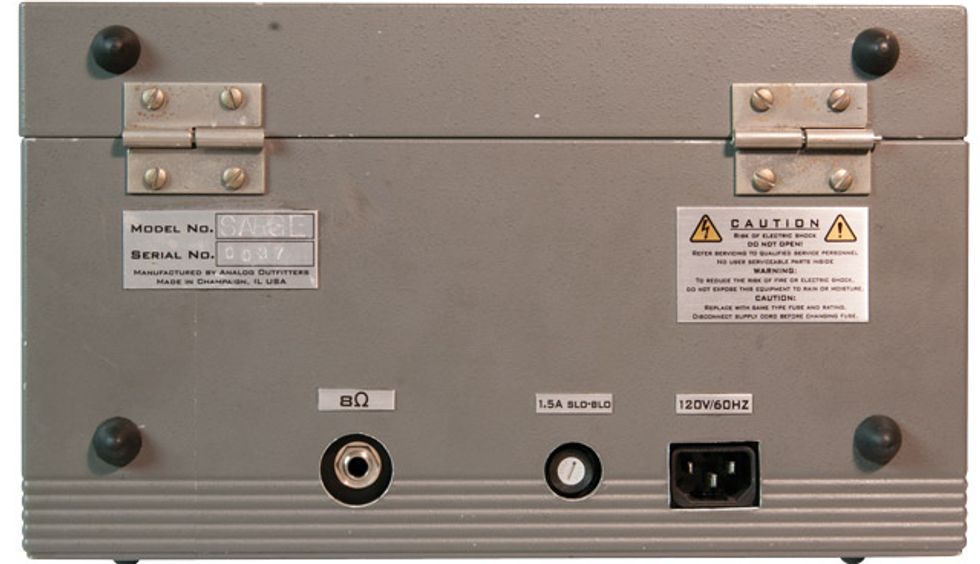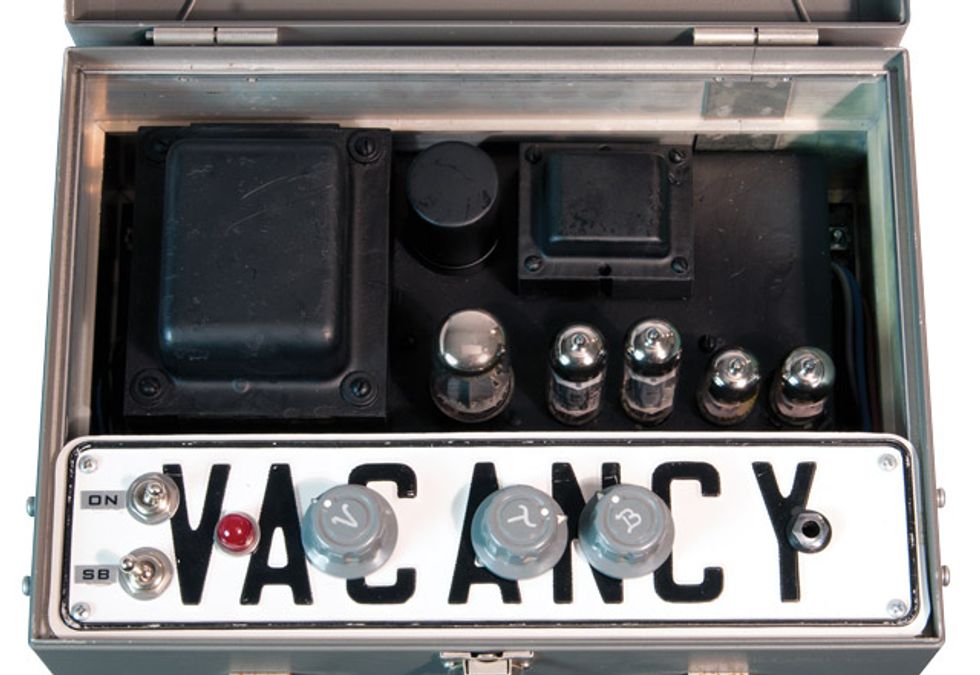The Champaign, Illinois, headquarters for Analog Outfitters is part junk shop, part audio monastery, and it’s staffed by a devout crew committed to mastering all things audio: If you’re planning a music festival, they’ll supply vintage gear, lighting, a mixing console, and even an engineer to patch it all together and run your sound. They also specialize in organ repair. Needless to say, these guys are a resourceful bunch. Given the oldschool parts (tubes, heavy-duty transformers) used in so many old organs—and the fact that old organs aren’t exactly the rage they once were—it’s little surprise they’ve also ventured into guitar amplification.
What’s doubly cool is that Analog Outfitters has parlayed its expertise across varied audio experiences and equipment. Their Sarge amp is a 15-watt, EL84-powered circuit that uses vintage Hammond organ transformers and a Fender Deluxe-style tone stack. Each amp is handbuilt with slightly different aesthetics, but uses the same basic components to deliver unique twists on classic tones.

Old Parts, New Ideas
Much of Sarge’s immediate appeal is
derived from the unique enclosure. Once
home to scientific equipment, these heavyduty
aluminum boxes are tough and highly
portable. Each enclosure is slightly different,
but they all have roughly the same
pillbox-like design. On the back, three
holes yield access to an 8 Ω speaker output,
a fuse, and the power-cord jack.
The Sarge is small enough to sit on a cabinet and solid enough to tough it out on the floor. Inside, you’ll find three controls affixed to a vintage embossed sign. The V knob controls volume, and T and B control the treble and bass EQ, respectively. There are also power and standby switches, and a red indicator light—it’s about as simple a control set as you’ll find. Behind these knobs lurks the Sarge’s ammunition—two EL84s in the power section, two 12AX7s for the preamp, and a 5Y3 rectifier.

Ah-ten-TION!
I ran the Sarge into a 4x10 cabinet where it
sat perched like a helmet on an armor-clad
mercenary—a singular red eye menacingly
surveying the dark studio, ready and
at attention. My Stratocaster was plugged
directly in, with volume around noon. At
15 watts, the Sarge saturates pretty quickly
as you roll the volume clockwise, but it
will bark with true field-sergeant authority,
too—easily hanging with a drummer and a
second guitarist. If you’re after a gritty tone,
Sarge does stand its ground.
With volume a little past noon, my Strat’s single-coils produced a razor-wire wall of sound—think punk-rock roots, London, in the late ’70s. And just rolling back the bass knob from my original 12 o’clock setting got me a tighter, more striking tone to counter the humbuckerequipped guitarist in my band. Later, I added a Fulltone Fulldrive to the signal chain, and it proved a great asset for lead playing, revealing a lot about how pedalfriendly this amp is—even with a fairly low saturation threshold. It’ll happily handle high-gain pedals and aggressive fuzz, too. A Big Muff clone retained it’s boomy character without getting mushy as many fuzzes do with low-watt amps. But even without the help of pedals, the amp’s natural sustain is rich and distinctly vintage. In terms of feel and tone, it has a very tweed Deluxelike personality. You shouldn’t expect to coax modern hi-gain compression at max volume, but that famous tweed compression is there in plentitude.
Ratings
Pros:
Classic, tweed-style tones with a twist. Vibey aesthetics.
Tough as nails.
Cons:
Difficult to get practical clean tones at performance
volumes.
Tones:
Ease of Use:
Build:
Value:
Street:
$799
Company
analogoutfitters.com
Switching to a humbucker-equipped Gibson Sonex launched the output volume through the roof. And kicking treble up a notch made the Sarge even better suited for lead duties without any pedal assistance. I really enjoyed keeping the Sarge at high volume and using the Sonex’s controls to accentuate rhythm and lead sections, and it’s easy to live out your Jimmy Page fantasies once you nail this technique. Rolling off your guitar’s volume knob is a great way to lasso the Sarge’s clean capabilities, though the volume decrease may make it hard to achieve a crystalline sound with a full band behind you.
The Verdict
The Analog Outfitters Sarge is a remarkable
amplifier dripping with mojo and fiery
furnace tone. If you love recording with
smaller amps, you’ll dig its multifaceted uses
and expansive personality. Those searching
for pure cleans—especially in a performance
context—should look elsewhere.
That said, at lower volumes you can achieve
real character and sensitivity with a softer
sting. Sarge also plays well with all pickups,
and great with fuzz boxes—delivering a lot
more range with effects than you might be
accustomed to from a low-wattage amp. It
may look like a piece of design gimmickry
to curmudgeonly purists, but it’s a practical
design—small enough to carry from the studio
to the stage, and tough enough to tour
with. Who says organ players can’t teach us
guitarists a thing or two about gear?








![Rig Rundown: Russian Circles’ Mike Sullivan [2025]](https://www.premierguitar.com/media-library/youtube.jpg?id=62303631&width=1245&height=700&quality=70&coordinates=0%2C0%2C0%2C0)


























